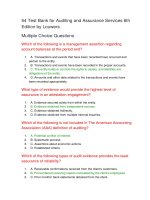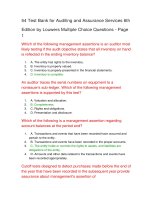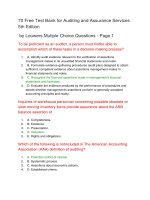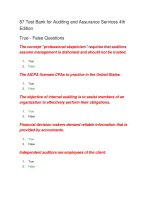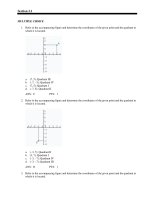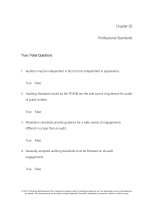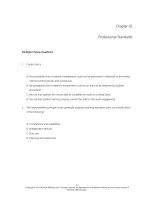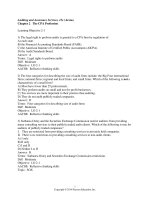Auditing and assurance services 6th edition louwers test bank
Bạn đang xem bản rút gọn của tài liệu. Xem và tải ngay bản đầy đủ của tài liệu tại đây (543.46 KB, 76 trang )
Chapter 02
Professional Standards
Multiple Choice Questions
1.
Control risk is
A. the probability that a material misstatement could not be prevented or detected by the entity's
internal control policies and procedures.
B. the probability that a material misstatement could occur and not be detected by auditors'
procedures.
C. the risk that auditors will not be able to complete the audit on a timely basis.
D. the risk that auditors will not properly control the staff on the audit engagement.
2.
The responsibilities principle under generally accepted auditing standards does not include which
of the following?
A. Competence and capabilities
B. Independent attitude
C. Due care
D. Planning and supervision
2-1
Copyright © 2015 McGraw-Hill Education. All rights reserved. No reproduction or distribution without the prior written consent of
McGraw-Hill Education.
3.
Which of the following types of auditors' reports does not require an additional paragraph to
support the opinion?
A. Unmodified opinion
B. Adverse opinion
C. Qualified opinion
D. Disclaimer of opinion
4.
Which of the following is an element of a system of quality control that should be considered by a
public accounting firm in establishing its quality control policies and procedures?
A. Lending credibility to a client's financial statements
B. Using statistical sampling techniques
C. Acceptance and continuance of client relationships and specific engagements
D. Membership in the Center for Public Company Audit Firms
5.
Which of the following presumptions does not relate to the reliability of audit evidence?
A. The more effective the client's internal control, the more assurance it provides about the
accounting data and financial statements.
B. The auditors' opinion, to be economically useful, is formed within reasonable time and based on
evidence obtained at a reasonable cost.
C. Evidence obtained from independent sources outside the entity is more reliable than evidence
secured solely within the entity.
D. The independent auditors' direct personal knowledge, obtained through observation and
inspection, is of higher quality than information obtained indirectly.
2-2
Copyright © 2015 McGraw-Hill Education. All rights reserved. No reproduction or distribution without the prior written consent of
McGraw-Hill Education.
6.
An important role of the Public Company Accounting Oversight Board is to oversee the
A. issuance of statements by the Financial Accounting Standards Board.
B. preparation and grading of the Uniform CPA Examination.
C. peer review of member firms of the Private Companies Practice Section.
D. regulation of firms that audit public entities.
7.
Audit evidence is usually considered sufficient when
A. it is reliable.
B. there is enough quantity to afford a reasonable basis for an opinion on financial statements.
C. it has the qualities of being relevant, objective, and free from unknown bias.
D. it has been obtained through random selection methods.
8.
Which of the following is not considered a type of audit evidence?
A. The entity's trial balance
B. Auditors' calculations
C. Physical observation
D. Verbal statements made by client personnel
9.
An audit of the financial statements of Camden Corporation is being conducted by external
auditors. The external auditors are expected to
A. certify the correctness of Camden's financial statements.
B. make a complete examination of Camden's records and verify all of Camden's transactions.
C. give an opinion on the fair presentation of Camden's financial statements in conformity with the
applicable financial reporting framework (e.g., GAAP, IFRS).
D. give an opinion on the attractiveness of Camden for investment purposes and critique the
wisdom and legality of its business decisions.
2-3
Copyright © 2015 McGraw-Hill Education. All rights reserved. No reproduction or distribution without the prior written consent of
McGraw-Hill Education.
10. Auditors try to achieve independence in appearance in order to
A. maintain public confidence in the profession.
B. become independent in fact.
C. comply with the responsibilities principle.
D. maintain an unbiased mental attitude.
11. The preparation of an audit plan prior to the beginning of fieldwork is appropriately considered
documentation of
A. planning.
B. supervision.
C. information evaluation.
D. quality assurance.
12. Which of the following procedures would provide the most reliable audit evidence?
A. Inquiries of the client's accounting staff held in private
B. Inspection of prenumbered client shipping documents
C. Inspection of bank statements obtained directly from the client's financial institution
D. Analytical procedures performed by auditors on the client's trial balance
13. Which of the following would most likely be a violation of the independence requirement found in
the responsibilities principle under generally accepted auditing standards?
A. An auditor on the engagement has a distant relative who is employed by a vendor that does a
significant amount of business with clients.
B. The client's Chief Executive Officer graduated from the same university as the partner in charge
of the accounting firm.
C. An auditor on the engagement owns a financial interest in the stock of the client.
D. The client provides financial support to a number of charitable causes that also receive support
from the accounting firm.
2-4
Copyright © 2015 McGraw-Hill Education. All rights reserved. No reproduction or distribution without the prior written consent of
McGraw-Hill Education.
14. A vendor's invoice received and held by the client would be considered what type of evidence?
A. External
B. Internal
C. External-internal
D. Written representation
15. Which of the following statements is generally correct about the appropriateness of audit
evidence?
A. Auditors' direct personal knowledge, obtained through observation and inspection, is of higher
quality than information obtained indirectly from independent outside sources.
B. To be reliable, audit evidence must be either valid or relevant, but need not be both.
C. Client accounting data alone may be considered sufficient appropriate audit evidence to issue
an unmodified opinion on client financial statements.
D. Appropriateness of audit evidence refers to the amount of corroborative evidence to be
obtained.
16. The standard auditors' report refers to standards of the PCAOB and GAAP in which paragraph?
A. Standards of the PCAOB: Scope only; GAAP: Opinion only
B. Standards of the PCAOB: Introductory only; GAAP: Scope and opinion
C. Standards of the PCAOB: Introductory and scope; GAAP: Opinion only
D. Standards of the PCAOB: Introductory only; GAAP: All paragraphs
2-5
Copyright © 2015 McGraw-Hill Education. All rights reserved. No reproduction or distribution without the prior written consent of
McGraw-Hill Education.
17. Which of the following is not included in the auditors' standard report representing an unmodified
opinion?
A. A brief indication of the responsibility of auditors and management for the financial statements
B. An indication that all appropriate disclosures have been made and included in the financial
statements
C. An indication that the audit was conducted in accordance with standards established by the
PCAOB
D. The auditors' opinion on the fairness of the financial statements
18. Internal evidence
A. is obtained directly from third parties independent of the client.
B. originates outside of the client's system but has been received and processed by the client.
C. consists of documents that are produced, used, and stored within the client's information
system.
D. consists of representations made by the client's officers, directors, owners, and employees.
19. Which of the following presumptions is correct about the reliability of audit evidence?
A. Information obtained indirectly from outside sources is the most reliable form of audit evidence.
B. To be reliable, audit evidence should be convincing rather than persuasive.
C. Reliability of audit evidence refers to the amount of corroborative evidence obtained.
D. An effective system of internal control provides more assurance about the reliability of audit
evidence.
20. The auditors' responsibility to express an opinion on the financial statements is
A. implicitly represented in the auditors' standard report.
B. explicitly represented in the introductory paragraph of the auditors' standard report.
C. explicitly represented in the scope paragraph of the auditors' standard report.
D. explicitly represented in the opinion paragraph of the auditors' standard report.
2-6
Copyright © 2015 McGraw-Hill Education. All rights reserved. No reproduction or distribution without the prior written consent of
McGraw-Hill Education.
21. Which of the following is not a concept from the performance principle under generally accepted
auditing standards?
A. The auditor must plan the work and properly supervise any assistants.
B. The auditor must express an opinion in accordance with the auditor's findings.
C. The auditor must obtain sufficient appropriate evidence about whether material misstatements
exist.
D. The auditor must determine and apply an appropriate materiality level throughout the audit.
22. Under generally accepted auditing standards, which of the following relates to the responsibilities
principle?
A. The initial planning of the audit engagement
B. The confirmation of accounts receivable
C. The completion of an internal control questionnaire
D. Maintaining professional skepticism and exercising professional judgment
23. Which of the following represent audit quality guides that remain stable over time and are
applicable for all audits?
A. Auditing procedures
B. Auditing standards
C. Due care
D. System of quality control
2-7
Copyright © 2015 McGraw-Hill Education. All rights reserved. No reproduction or distribution without the prior written consent of
McGraw-Hill Education.
24. Which of the following situations would most likely be in conflict with the responsibilities
principle?
A. Auditors perform the engagement with the performance level expected of prudent auditors, but
not expert auditors.
B. Auditors obtain expertise in their client's industry as they are conducting the audit examination.
C. Auditors are directly involved with a client manager in a strategic decision-making capacity.
D. Auditors fail to document their assessment of control risk following their study of internal
control.
25. Which of the following statements is not true with respect to the evidence that would be gathered
when assessments of control risk are high?
A. Auditors would be required to rely on external (rather than internal) forms of evidence.
B. Auditors would be required to perform procedures at interim periods, rather than at year end.
C. Auditors would be required to confirm a larger number of customer accounts receivable
balances.
D. Auditors would be required to obtain more evidence through direct personal observation.
26. As it relates to audit evidence, appropriateness refers to the
A. originality of evidence gathered.
B. quality of evidence gathered.
C. quantity of evidence gathered.
D. timeliness of evidence gathered.
27. Which of the following information would not be included in the auditors' standard report?
A. The names of the financial statements audited
B. A description of the nature of an audit
C. An indication that all necessary disclosures have been presented
D. An opinion on the entity's financial statements
2-8
Copyright © 2015 McGraw-Hill Education. All rights reserved. No reproduction or distribution without the prior written consent of
McGraw-Hill Education.
28. The primary purpose of the auditors' study of internal control for a nonpublic entity is
A. to provide constructive suggestions to the client for improving its internal control.
B. to report on internal control as required by Auditing Standard No. 5.
C. to identify and detect fraud and irregularities perpetrated by client personnel.
D. to determine the nature, timing, and extent of further audit procedures.
29. Which reporting options do auditors have if the client's financial statements are not presented
according to the applicable financial framework (e.g., GAAP, IFRS)?
A. Unmodified opinion or disclaimer of opinion
B. Qualified opinion or disclaimer of opinion
C. Unmodified opinion or adverse opinion
D. Qualified opinion or adverse opinion
30. Which of the following statements is true with respect to the quality of audit evidence?
A. Quality is related to the relevance of evidence, but not the reliability of evidence.
B. Evidence is considered of higher quality when gathered prior to year-end than following yearend.
C. Evidence obtained under environments of stronger internal control is of higher quality than
evidence obtained under environments of weaker internal control.
D. In evaluating quality, sufficiency of evidence is of greater importance than appropriateness of
evidence.
31. Which of the following concepts is least related to the risk of material misstatement?
A. Control risk
B. Detection risk
C. Inherent risk
D. Materiality
2-9
Copyright © 2015 McGraw-Hill Education. All rights reserved. No reproduction or distribution without the prior written consent of
McGraw-Hill Education.
32. Which of the following statements describes an appropriate relationship with respect to the
reliability of audit evidence?
A. Receiving confirmation from third parties as to the existence of securities is more reliable than
the auditors' personal inspection of those securities.
B. Verbal inquiries received from the client regarding sales made to customers are more reliable
than sales invoices prepared by the client for its customers.
C. A bank confirmation received directly by the auditor is more reliable than a bank confirmation
initially received by the client and forwarded to the auditor.
D. Evidence drawn from a document prepared by the client is more reliable than evidence drawn
from a document prepared by an external party that is forwarded to the auditor by the client.
33. A periodic review of an audit firm's system of quality control by the PCAOB is referred to as a(n)
A. inspection.
B. peer review.
C. principles review.
D. quality review.
34. The performance principle would include all of the following except
A. the auditors' determination of materiality levels.
B. the auditors' evaluation of independence with respect to their clients.
C. the auditors' evaluation of the risk of material misstatement.
D. the auditors' determination of the nature, timing, and extent of further audit procedures.
35. Which of the following is most closely associated with the responsibilities principle?
A. Due care
B. Planning
C. Qualified audit opinion
D. Risk of material misstatement
2-10
Copyright © 2015 McGraw-Hill Education. All rights reserved. No reproduction or distribution without the prior written consent of
McGraw-Hill Education.
36. Which of the following statements is not true with respect to the responsibility for establishing
generally accepted auditing standards?
A. The PCAOB issues auditing standards for the audit of public entities, subject to SEC approval
B. Standards issued by the Auditing Standards Board after 2003 apply to the audits of both public
and private entities
C. If not superseded by the PCAOB, Statements on Auditing Standards issued prior to 2003 are
applicable to the audit of public entities
D. Prior to the Sarbanes-Oxley Act, the Auditing Standards Board issued auditing standards for the
audits of both public and private entities
37. Which of the following would normally be considered earliest in the audit examination?
A. Determination of materiality levels for use during the audit
B. Consideration of the ability of the entity's internal control to prevent or detect errors
C. Preparation of a written audit plan
D. Evaluation of the type of audit opinion to be issued, based on the auditor's findings
38. The state of mind that characterizes the auditors' appropriate questioning and critical assessment
of audit evidence is referred to as
A. due care.
B. independence in appearance.
C. professional judgment.
D. professional skepticism.
2-11
Copyright © 2015 McGraw-Hill Education. All rights reserved. No reproduction or distribution without the prior written consent of
McGraw-Hill Education.
39. Which of the following is least related to the concept of independence in appearance?
A. The auditors' objectivity and ability to act impartially toward the client
B. The perceptions of individuals who rely on the financial statements and auditors' opinion on the
financial statements
C. The ownership of a financial interest in a client by the auditor
D. The employment of the auditor's family member in an important position with the client
40. The concept of _________ recognizes that a GAAS audit may fail to detect all material
misstatements.
A. absolute assurance
B. due care
C. reasonable assurance
D. risk of material misstatement
41. Generally accepted auditing standards are
A. specific actions performed by auditors during an examination.
B. standards that guide the conduct of an audit examination.
C. legal requirements auditors must observe during the audits of public entities.
D. standards used by entities in deciding whether to engage or retain the services of auditors.
2-12
Copyright © 2015 McGraw-Hill Education. All rights reserved. No reproduction or distribution without the prior written consent of
McGraw-Hill Education.
42. Which of the following could serve as a source of professional guidance in the audit of a public
entity?
A. Option A
B. Option B
C. Option C
D. Option D
43. Which of the following is not true with respect to the responsibilities for establishing generally
accepted auditing standards?
A. Auditing standards for both public and private entities must be formally approved by the
Securities and Exchange Commission.
B. Interpretive publications are issued by the AICPA to provide guidance on the application of
generally accepted auditing standards in specific circumstances.
C. The PCAOB is the body with formal authority for the creation of auditing standards for the
audits of public entities.
D. If specific guidance is not provided by PCAOB Auditing Standards, auditors may refer to
Statements on Auditing Standards that have not been amended or superseded.
2-13
Copyright © 2015 McGraw-Hill Education. All rights reserved. No reproduction or distribution without the prior written consent of
McGraw-Hill Education.
44. Which of the following is not related to the responsibilities principle?
A. Continuing professional education to ensure that professionals' knowledge keeps pace with
changes in the accounting and auditing profession
B. Firm-wide policies to evaluate the financial and professional relationships of its professionals
C. Specific auditing procedures designed to determine the effectiveness of the entity's internal
control over financial reporting
D. The auditors' use of professional judgment throughout the examination
45. A level of performance that would be exercised by reasonable auditors in similar circumstances is
referred to as
A. due care.
B. independence.
C. professional judgment.
D. professional skepticism.
46. During which stages of an audit examination are auditors required to exhibit the appropriate use
of professional judgment?
A. Option A
B. Option B
C. Option C
D. Option D
2-14
Copyright © 2015 McGraw-Hill Education. All rights reserved. No reproduction or distribution without the prior written consent of
McGraw-Hill Education.
47. Which of the following is not true with respect to the concept of reasonable assurance?
A. Reasonable assurance allows for mistakes and misinterpretations by the audit team throughout
the examination.
B. The nature of many audit procedures is such that they cannot always be relied upon to detect
misstatements.
C. Audit teams should evaluate all transactions and components of an account balance or class of
transactions.
D. Auditors should control the overall risk in an audit to an acceptably low level.
48. Which of the following factors influences the risk of material misstatement?
A. Option A
B. Option B
C. Option C
D. Option D
49. Which of the following is not true with respect to the auditors' report for a public entity?
A. The report title should contain the word "independent."
B. The report provides a detailed listing of major auditing procedures performed during the
examination.
C. The opinion assesses the financial statements against an applicable financial reporting
framework.
D. The report specifically identifies the financial statements and years examined by the auditor.
2-15
Copyright © 2015 McGraw-Hill Education. All rights reserved. No reproduction or distribution without the prior written consent of
McGraw-Hill Education.
50. Which of the following paragraphs references the conduct of the audit in accordance with PCAOB
standards?
A. Introductory paragraph
B. Scope paragraph
C. Opinion paragraph
D. Internal control paragraph
51. Which of the following is true with respect to the PCAOB inspection process?
A. All firms performing audits of public entities are inspected every year.
B. PCAOB inspections are conducted by partners of other CPA firms.
C. PCAOB inspection teams review a sample of audit engagements conducted by the firm as well
as the firm's system of quality control.
D. Deficiencies from sample audit engagements reviewed by the inspection team and deficiencies
in the firm's system of quality control are publicly disclosed on the PCAOB's website.
52. Which of the following would be evaluated during the PCAOB inspection process?
A. Option A
B. Option B
C. Option C
D. Option D
2-16
Copyright © 2015 McGraw-Hill Education. All rights reserved. No reproduction or distribution without the prior written consent of
McGraw-Hill Education.
53. The Public Company Accounting Oversight Board was established by which of the following?
A. The Financial Accounting Standards Board
B. The American Institute of Certified Public Accountants
C. The Sarbanes-Oxley Act of 2002
D. The International Accounting Standards Board
54. Which of the following types of audit evidence provides the least assurance of reliability?
A. Receivable confirmations from the client's customers
B. Prenumbered receiving reports completed by the client's employees
C. Prior months' bank statements obtained from the client
D. Municipal property tax bills prepared in the client's name
55. A CPA firm would provide itself reasonable assurance of meeting its responsibility to offer
professional services that conform with professional standards by
A. establishing an understanding with each client concerning individual responsibilities in a signed
engagement letter.
B. assessing the risk that errors and fraud may cause the financial statements to contain material
misstatements.
C. developing specific audit objectives to support management's assertions that are embodied in
the financial statements.
D. maintaining a comprehensive system of quality control that is suitably designed in relation to its
organizational structure.
2-17
Copyright © 2015 McGraw-Hill Education. All rights reserved. No reproduction or distribution without the prior written consent of
McGraw-Hill Education.
56. Which of the following courses of action is most appropriate if an auditor concludes that there is a
high risk of material misstatement?
A. Use smaller, rather than larger, sample sizes.
B. Perform substantive tests as of an interim date.
C. Select more effective substantive tests.
D. Increase tests of controls.
57. Which of the following actions should a CPA firm take to comply with the AICPA's quality control
standards?
A. Establish procedures that comply with the standards of the Sarbanes-Oxley Act.
B. Use attributes sampling techniques in testing internal controls.
C. Consider inherent risk and control risk before determining detection risk.
D. Establish policies to ensure that the audit work meets applicable professional standards.
58. Which of the following is a definition of control risk?
A. The risk that a material misstatement will not be prevented or detected on a timely basis by the
client's internal controls
B. The risk that the auditor will not detect a material misstatement
C. The risk that the auditor's assessment of internal controls will be at less than the maximum level
D. The susceptibility of material misstatement assuming there are no related internal control
policies or procedures
2-18
Copyright © 2015 McGraw-Hill Education. All rights reserved. No reproduction or distribution without the prior written consent of
McGraw-Hill Education.
59. Prior to, or in conjunction with, the information-gathering procedures for an audit, audit team
members should discuss the potential for material misstatement due to fraud. Which of the
following best characterizes the mindset that the audit team should maintain during this
discussion?
A. Presumptive
B. Judgmental
C. Criticizing
D. Questioning
60. An independent auditor must have which of the following?
A. A pre-existing and well-informed point of view with respect to the audit
B. Technical training that is adequate to meet the requirements of a professional
C. A background in many different disciplines
D. Experience in taxation that is sufficient to comply with generally accepted auditing standards
61. What type of evidence would provide the highest level of assurance in an attestation
engagement?
A. Evidence secured solely from within the entity
B. Evidence obtained from independent sources
C. Evidence obtained indirectly
D. Evidence obtained from multiple internal inquiries
62. Which of the following is an important consideration during the planning of the audit?
A. Considering the independence of members of the audit team
B. Performing some of the audit procedures prior to the end of the year under audit
C. Considering the ability and expertise of the audit team with respect to accounting and auditing
issues in the client's industry
D. Considering the impact of tests of controls on the overall assessment of control risk
2-19
Copyright © 2015 McGraw-Hill Education. All rights reserved. No reproduction or distribution without the prior written consent of
McGraw-Hill Education.
63. The initial development of auditing standards was in response to
A. a scandal involving embezzlement that was not detected during an audit engagement.
B. auditors' concerns that all components of the financial statements were not being verified.
C. independent inquiries of the public accounting profession made by the SEC.
D. requests by companies for greater assurance with respect to the auditors' ability to detect
financial statement misstatements.
64. All of the following statements are true regarding generally accepted auditing standards (GAAS)
except
A. departures from auditing standards that impose presumptively mandatory requirements on
auditors are not permitted under any circumstances.
B. Interim Auditing Standards, issued by the AICPA, may serve as an appropriate source of GAAS
for the audits of public entities.
C. separate auditing standards have been developed for the audits of U.S. governmental entities
and foreign entities.
D. Interpretive Publications, which are officially considered less authoritative and less binding than
auditing standards, are included as part of GAAS.
65. The particular and specialized actions that auditors undertake to obtain evidence in a specific audit
engagement are known as
A. Interim Auditing Standards.
B. audit procedures.
C. Interpretive Publications.
D. Statements on Auditing Standards.
2-20
Copyright © 2015 McGraw-Hill Education. All rights reserved. No reproduction or distribution without the prior written consent of
McGraw-Hill Education.
66. The role of the Public Company Accounting Oversight Board in the standard-setting process is to
develop
A. Statements on Auditing Standards for the audits of nonpublic entities.
B. Auditing Standards for the audits of public entities.
C. Governmental Auditing Standards for the audits of governmental entities.
D. International Standards on Auditing for the audits of foreign entities.
67. Pronouncements issued by the Public Company Accounting Oversight Board are subject to formal
approval by the
A. American Institute of Certified Public Accountants.
B. Auditing Standards Board.
C. International Auditing and Assurance Standards Board.
D. Securities and Exchange Commission.
68. The three fundamental principles underlying GAAS include all of the following, except
A. general principle.
B. performance principle.
C. reporting principle.
D. responsibilities principle.
69. The fundamental principles developed by the Auditing Standards Board are best described as
A. ten basic standards underlying an audit.
B. standards that apply only to audits of public entities.
C. industry-specific guidance on how audit procedures should be conducted.
D. guidelines for the general conduct of audit engagements.
2-21
Copyright © 2015 McGraw-Hill Education. All rights reserved. No reproduction or distribution without the prior written consent of
McGraw-Hill Education.
70. The relevant ethical requirements relating to due care, professional skepticism, and professional
judgment are responsibilities of the auditor at which stage(s) of the audit?
A. Option A
B. Option B
C. Option C
D. Option D
71. Which of the following does not directly relate to an auditor's responsibility for having appropriate
competence and capabilities to perform the audit?
A. Participating in continuing professional education
B. Gaining experience through hands-on practice
C. Obtaining reliable documentary evidence
D. Attending on-the-job training
72. Which of the following situations would result in the issuance of a disclaimer of opinion?
A. The audit reveals weaknesses in the client's internal control over financial reporting.
B. The auditor is discovered to own a financial interest in the entity.
C. The audit is performed, with limited exception, in accordance with generally accepted auditing
standards.
D. The entity's financial statements are not presented in conformity with the applicable financial
reporting framework.
2-22
Copyright © 2015 McGraw-Hill Education. All rights reserved. No reproduction or distribution without the prior written consent of
McGraw-Hill Education.
73. In a system of quality control, leadership responsibilities for quality within the firm are best
characterized by
A. basing personnel performance evaluations on the employees' ability to generate revenues from
existing clients or by acquiring new clients.
B. management's evaluation of the integrity and business reputation of the client.
C. management's clear and consistent demonstration of its own commitment to quality control
and high-quality work.
D. assigning management responsibilities in such a manner that commercial considerations are the
firm's top priority.
74. The audit failures of both Enron and WorldCom were examples in which the leadership
responsibilities for quality work within the accounting firm were overshadowed by fears that losing
a key client would
A. result in shareholder losses from reduced company profitability.
B. require additional audit procedures and increase the fees paid by the companies to the
accounting firm.
C. negatively influence the results of the firm's inspection.
D. negatively impact individual auditors' performance evaluations.
75. Which of the following is an example of the appropriate implementation of a system of quality
control?
A. The firm requires all documents obtained during the audit to be destroyed immediately
following the engagement to ensure the client's information remains confidential.
B. The firm's quality control policies have evolved through the performance of audit procedures
but are not formally developed or communicated to staff members.
C. All firm employees must verbally confirm their compliance with the appropriate independence
requirements before being assigned to an engagement.
D. The firm uses manuals and standardized forms for audit documentation to help ensure
engagement performance objectives and quality standards are met.
2-23
Copyright © 2015 McGraw-Hill Education. All rights reserved. No reproduction or distribution without the prior written consent of
McGraw-Hill Education.
76. An internal evaluation of the significant judgments made by the audit team and the conclusions
reached in formulating its report for engagements meeting specified criteria is known as a(n)
A. engagement quality control review.
B. inspection.
C. peer review.
D. performance control evaluation.
77. Which element of a system of quality control strives to provide the firm with reasonable assurance
that its policies and procedures are operating effectively?
A. Human resources
B. Leadership responsibilities for quality within the firm
C. Monitoring
D. Relevant ethical requirements
78. When a firm decides to withdraw from an engagement, it should document all of the following
except
A. significant issues influencing the decision to withdraw from the engagement.
B. the basis for any conclusions related to this decision to withdraw from the engagement.
C. significant consultations related to the decision to withdraw from the engagement.
D. significant effects the decision to withdraw from the engagement could have on the firm.
79. Firm A performs audits of 60 public entities, while firm B performs audits of 120 public entities.
How often must each firm undergo a PCAOB inspection?
A. Both firm A and firm B will be inspected every other year.
B. Firm A will be inspected annually and firm B will be inspected every three years.
C. Firm A will be inspected every three years and firm B will be inspected annually.
D. Both firm A and firm B will be inspected annually.
2-24
Copyright © 2015 McGraw-Hill Education. All rights reserved. No reproduction or distribution without the prior written consent of
McGraw-Hill Education.
80. PCAOB inspections are conducted by
A. individuals selected by the PCAOB who are not current employees of public accounting firms.
B. another public accounting firm selected by the firm being inspected.
C. current employees of another public accounting firm selected by the PCAOB.
D. the AICPA's Public Oversight Board.
81. All of the following are examples of procedures a firm can use to monitor its system of quality
control except
A. discussions with firm personnel.
B. conducting reviews of engagement documentation.
C. devoting sufficient resources to developing a system of quality control.
D. assessing compliance with independence policies and procedures.
Essay Questions
2-25
Copyright © 2015 McGraw-Hill Education. All rights reserved. No reproduction or distribution without the prior written consent of
McGraw-Hill Education.
